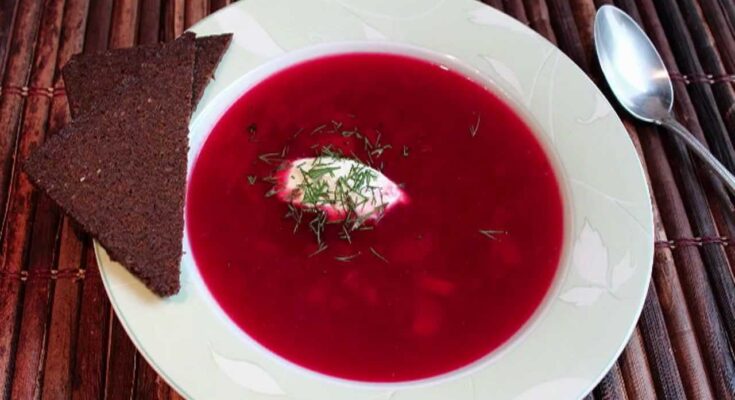Beet Soup Recipe: Beet soup—also known as borscht in Eastern Europe—isn’t just a bowl of red goodness; it’s a cultural symbol, a comfort food, and a nutritional powerhouse all rolled into one. If you’ve never made it from scratch, you’re in for a treat. This hearty, earthy, and often slightly tangy soup hits all the right notes: sweet from the beets, savory from the broth, and creamy if you choose to swirl in a bit of sour cream. Whether you’re cooking for health, flavor, or curiosity, beet soup offers an experience that goes beyond a basic vegetable broth.
What makes beet soup special is how customizable it is. Want to keep it vegan? Easy. Prefer the traditional version with tender chunks of beef or pork? Go for it. This step-by-step guide walks you through everything from choosing the best beets to simmering up a soul-warming pot of soup that’s worthy of any family table—or Instagram feed.
So tie on that apron, and let’s turn those ruby-red roots into a dish you’ll crave again and again.
Health Benefits of Beet Soup
Let’s be honest—beets are nutritional rockstars. And when you turn them into a soup? You’re practically sipping wellness by the spoonful. Here’s why beet soup deserves a regular spot on your menu:
- High in Antioxidants: Beets are rich in betalains, pigments known for their antioxidant and anti-inflammatory properties. These help combat oxidative stress, which is linked to aging and diseases like cancer.
- Great for Your Heart: Thanks to their natural nitrates, beets help widen blood vessels, which can reduce blood pressure and improve heart health.
- Supports Liver Function: Beets are packed with betaine, a compound that supports liver detoxification and function.
- Digestive Health Boost: With their high fiber content, beets help keep things moving smoothly through your digestive tract.
- Low in Calories, High in Nutrients: You get vitamins A, C, potassium, iron, folate, and magnesium—all for less than 60 calories per cup.
Plus, beet soup is naturally gluten-free and can be made vegetarian or vegan with just a few tweaks. It’s not just a pretty soup; it’s a smart choice too.
Different Variations of Beet Soup Around the World
Beet soup has been adopted—and adapted—by many cultures, each adding their own signature twist.
Russian Borscht
Russian-style borscht typically includes beef or pork for a hearty touch. The soup is slow-cooked with cabbage, potatoes, carrots, and garlic, then finished with a dollop of sour cream and chopped dill. It’s rich, satisfying, and ideal for cold nights.
Ukrainian Beet Soup
Ukrainian borscht is often considered the “gold standard.” It’s deep red in color, slightly tangy due to vinegar or lemon juice, and features beans, cabbage, and sometimes mushrooms. It can be served hot or cold.
Polish Barszcz
This version is usually clear and broth-based, without chunks of vegetables. It’s often served as a first course at Christmas Eve dinners, paired with mushroom-filled dumplings called uszka. Light, elegant, and flavorful.
Each version is worth trying, but the base—those glorious beets—stays constant across all interpretations.
What You’ll Need: Essential Kitchen Equipment
Before diving into the cooking process, let’s talk gear. You don’t need a professional kitchen setup, but having these tools on hand will make your life a lot easier:
- Large soup pot or Dutch oven
- Sharp knife and vegetable peeler
- Cutting board
- Wooden spoon or spatula
- Blender or immersion blender (optional)
- Ladle
- Mixing bowls
- Cheese grater (for finely shredding beets)
Trust me, prep is half the battle. Once your setup is ready, the process flows smoothly.
List of Ingredients You’ll Need
This beet soup recipe focuses on balance—earthy, sweet, savory, and tangy. Feel free to tweak based on your dietary needs and flavor preferences.
Fresh Vegetables
- 4 medium beets, peeled and grated or diced
- 2 carrots, chopped
- 1 onion, finely diced
- 2 garlic cloves, minced
- 1 small potato, diced
- 1 cup shredded cabbage
- 1 stalk celery (optional)
Spices and Herbs
- Salt and black pepper, to taste
- 1 bay leaf
- 1 tsp paprika (optional)
- Fresh dill for garnish
- 1 tbsp lemon juice or vinegar (for tang)
Optional Protein Add-ins
- ½ lb beef stew meat or pork (traditional)
- 1 can kidney beans or white beans (vegan protein option)
Garnishes
- Sour cream or Greek yogurt
- Fresh dill
- Hard-boiled egg (optional)
- Croutons or rye bread
With these ingredients in place, you’re ready to make magic happen on the stove.
Choosing the Best Beets for Soup
Beets are the heart and soul of this dish, so picking the right ones is key. Here’s how to select the perfect beets for soup:
- Go for Medium Size: Large beets can be woody inside, while small ones might lack depth of flavor. Medium beets strike a perfect balance.
- Check for Firmness: Your beets should be rock-solid with smooth, unblemished skin.
- Fresh is Best: If you can find beets with greens still attached, that’s a sign of freshness. Bonus: beet greens are delicious when sautéed or added to the soup!
- Color Matters: Red beets are the most common, but golden and striped (Chioggia) beets can add interesting flavor and appearance. For a traditional deep red borscht, stick with classic red beets.
Once you’ve got your beets, store them in the fridge until you’re ready to cook. Wash thoroughly to remove dirt, and always peel before cooking.
Prepping Your Ingredients: Tips for Success
Preparation is everything when it comes to making soup that tastes as good as it looks. Here are a few tips to help you prep like a pro:
- Wear gloves while peeling and grating beets—unless you like purple hands.
- Use a food processor for grating beets if you’re short on time.
- Soak your chopped potatoes in cold water while prepping other ingredients. This removes excess starch and helps keep the soup clear.
- Cut vegetables evenly so they cook at the same rate.
- Mince your garlic finely for maximum flavor infusion.
By doing a bit of work upfront, you’ll streamline the cooking process and avoid that last-minute scramble that often leads to burned onions or forgotten spices.
Step-by-Step Guide to Making Beet Soup
Now comes the heart of this guide—actually making your beet soup. Whether you’re aiming for a cozy weeknight dinner or impressing guests at a dinner party, these step-by-step instructions will guide you to perfection.
Step 1: Wash, Peel, and Dice the Beets
Start by thoroughly washing your fresh beets to remove any dirt. Peel them using a vegetable peeler, then dice them into small, even cubes. This helps them cook faster and blend more smoothly later.
Step 2: Sauté the Aromatics
In a large pot, heat a little olive oil or butter. Add chopped onions and minced garlic, sautéing until fragrant and slightly golden. This creates the flavorful base of your soup.
Step 3: Add Vegetables and Simmer
Add the diced beets, along with chopped carrots, potatoes, and celery if you like. Pour in vegetable or chicken broth, bring to a boil, then reduce the heat and simmer until the beets are tender.
Step 4: Season to Taste
Add salt, pepper, and a splash of lemon juice or vinegar for brightness. Taste and adjust to your liking.
Step 5: Blend or Leave Chunky (Your Call)
Use an immersion blender to purée the soup for a silky texture—or leave it chunky for a rustic feel. Serve warm with a dollop of sour cream or yogurt and a sprinkle of herbs.
Serving Suggestions
Beet soup is one of those versatile dishes that can be dressed up or down, served hot or cold, and still shine in every scenario. Here’s how to make the most of your hard work.
Hot vs Cold Beet Soup
- Hot: A steaming bowl of beet soup on a winter evening is pure comfort. It pairs well with crusty bread, grilled cheese, or a warm salad.
- Cold: In the summer months, chill your beet soup and serve it as a refreshing appetizer. It’s cooling, light, and packed with flavor. Just be sure to refrigerate it for at least 2 hours before serving.
Best Side Dishes to Pair With
- Crusty rye bread or sourdough
- Garlic toast
- Hard-boiled eggs
- Cheese-stuffed pierogies
- Fresh garden salad with vinaigrette
And don’t forget the garnishes! A swirl of sour cream or yogurt, a sprinkle of dill, and a grind of fresh black pepper can turn your beet soup into a masterpiece.
How to Make Vegan Beet Soup
The beauty of beet soup is how effortlessly it transforms into a vegan dish. Here’s how to go plant-based without sacrificing taste:
- Use vegetable broth instead of beef or chicken stock.
- Skip the meat and opt for protein-rich add-ins like kidney beans, chickpeas, or lentils.
- Swap sour cream for vegan alternatives like cashew cream, coconut yogurt, or soy-based products.
- Flavor Boosters: Use smoked paprika, nutritional yeast, and lemon juice to build that umami profile.
Pro tip: Let your vegan beet soup sit for a few hours before serving. The flavors deepen beautifully over time.
How to Add Meat (Traditional Borscht)
Want to go the traditional Slavic route? Adding meat to your beet soup creates a more robust, filling meal. Here’s how to do it right:
- Best meat cuts: Use beef chuck, short ribs, pork shoulder, or even bone-in cuts for maximum flavor.
- Brown your meat first: Before adding vegetables, sear your meat in a bit of oil to develop flavor.
- Simmer longer: If using tougher cuts, let the soup simmer for 1.5 to 2 hours until the meat is fork-tender.
- Skim the foam: If your meat produces any scum during boiling, skim it off with a spoon to keep the broth clear.
Add the beets later in the process if you’re doing a long simmer to maintain their vibrant color and texture.
Make-Ahead Tips and Storage Instructions
Beet soup is one of those rare dishes that actually gets better the next day. Here’s how to store and prep ahead:
- Make ahead: Cook the soup up to 2 days in advance and refrigerate. Flavors will deepen over time.
- Refrigerate properly: Store in an airtight container for up to 5 days.
- Reheat gently: Use the stovetop on low heat, stirring occasionally. Avoid boiling again to preserve color and flavor.
Pro tip: Add garnishes like sour cream and fresh herbs only when serving to keep them fresh and vibrant.
How to Freeze Beet Soup Without Losing Flavor
Freezing soup? Totally doable—but there’s a right way to do it. Here’s how:
- Cool first: Let the soup cool completely before transferring to freezer containers.
- Use airtight containers or freezer bags: Leave a bit of space at the top for expansion.
- Freeze without dairy: If you’re using sour cream or yogurt, don’t add it before freezing. Stir it in after reheating.
- Label and date: Beet soup keeps well for 2–3 months in the freezer.
To serve, thaw overnight in the fridge and reheat on the stovetop. Easy!
Common Mistakes to Avoid When Making Beet Soup
Even though beet soup seems simple, a few missteps can throw off the flavor or texture. Here are some common mistakes to steer clear of:
- Overcooking beets: This makes them lose color and turn mushy.
- Adding vinegar too early: Acidity can prevent vegetables from softening. Always add it near the end.
- Using low-quality broth: The base makes or breaks your soup. Use homemade or high-quality store-bought broth.
- Skipping the garnish: A swirl of sour cream or a dash of lemon juice adds contrast and brings the dish to life.
- Not tasting as you go: The flavor balance is key—don’t wait until the end to adjust seasoning.
With these tips, you’ll be well on your way to beet soup bliss.
FAQs about Beet Soup Recipe
1. Can I use canned beets for beet soup?
Yes, but fresh beets offer better texture and deeper flavor. If using canned, rinse them well and reduce the simmering time.
2. How do I prevent my beet soup from turning brown?
Add a splash of vinegar or lemon juice near the end of cooking to preserve the vibrant red color.
3. What’s the difference between borscht and beet soup?
Borscht is a type of beet soup, typically with more ingredients like meat, cabbage, and potatoes. It’s a traditional Eastern European version.
4. Is beet soup good for weight loss?
Absolutely. It’s low in calories, high in fiber, and helps you feel full longer. Just watch out for high-fat toppings.
5. Can I serve beet soup cold?
Yes! It’s delicious chilled—perfect for a summer appetizer. Just refrigerate for a few hours before serving.
Conclusion
Beet soup is more than just a dish—it’s a delicious dive into culinary tradition, a comfort in cold weather, and a powerhouse of health benefits. Whether you’re making it vegan, vegetarian, or loaded with tender beef, it’s hard to mess up if you follow the steps we’ve laid out.
So next time you’re staring down a bunch of beets at the farmer’s market, don’t pass them up. Turn them into a soup that’s sweet, savory, and so satisfying you’ll want to make a double batch. And remember, like all great soups, beet soup is about patience, balance, and just a little bit of love stirred into the pot.



